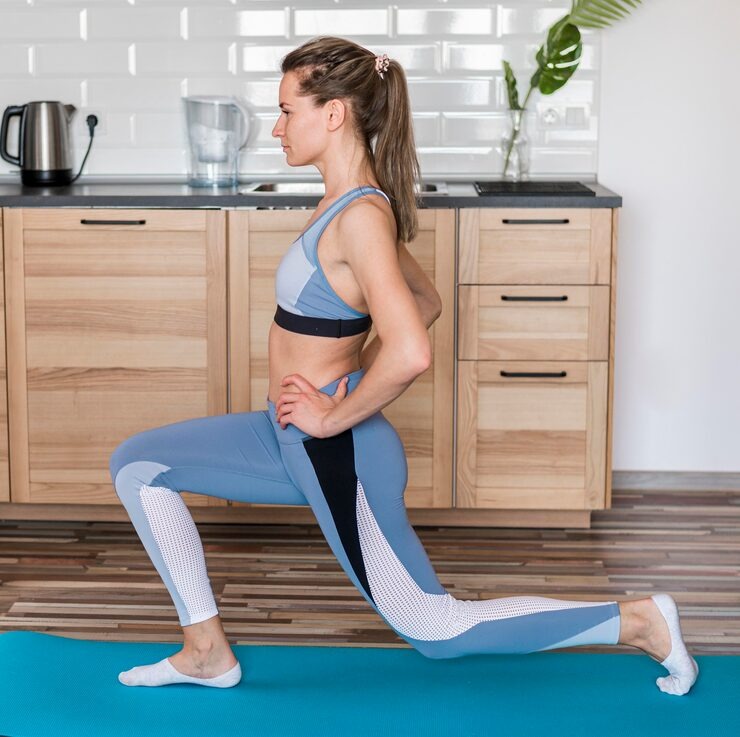Hey there, friend. Let me take you back a few years to when I first discovered the magic of resistance bands. I was stuck in a tiny apartment during a rainy season that seemed endless, dreaming of a gym membership but settling for what I had on hand—a cheap set of looped bands I’d impulse-bought online. Skeptical at first, I looped one around my thighs and dove into some basic moves. Fast forward a month, and my glutes felt firmer, my posture improved, and I even noticed a subtle lift in my step (literally). It wasn’t about chasing some Instagram-perfect booty; it was the confidence boost from feeling stronger in everyday life, like climbing stairs without huffing or chasing after my dog at the park. If you’re here because you want that same empowering shift—whether you’re a beginner dipping your toes into fitness or someone looking to spice up home workouts—this 5-move routine is your ticket. We’ll build a strong, functional butt that supports you through life, not just looks good in jeans. Stick with me; I’ve got the details to make it happen.
What Are Resistance Bands?
Resistance bands are stretchy, elastic tools made from latex, rubber, or fabric that add tension to exercises, forcing your muscles to work harder against the pull. They’re like portable weights but lighter and more versatile, perfect for targeting specific areas like the glutes without bulky equipment. Think of them as your glute’s best friend—they provide constant resistance throughout a movement, unlike free weights that rely on gravity alone.
Benefits of Resistance Band Workouts for Glutes
Training your glutes with bands isn’t just about aesthetics; it’s a game-changer for overall health and performance. These workouts activate the three main glute muscles—maximus, medius, and minimus—helping stabilize your hips and pelvis during daily activities. From my own experience, incorporating bands reduced my lower back twinges after long desk days, making me feel more balanced and energetic.
- Improved Strength and Tone: Bands create progressive tension, leading to muscle growth and a firmer butt over time.
- Better Posture and Balance: Strong glutes support your spine, reducing slouching and enhancing stability.
- Injury Prevention: They strengthen stabilizing muscles, lowering risks for knee or hip issues, especially for runners or desk workers.
- Convenience and Versatility: Portable and affordable, bands fit any space—great for travel or quick sessions.
- Joint-Friendly: Less impact than heavy weights, ideal for beginners or those with arthritis.
Humorously, bands also add a fun challenge; nothing humbles you like a band snapping back mid-squat, reminding you to keep form tight!
Choosing the Right Resistance Bands for Beginners
Starting out? Opt for a set with varying strengths to progress safely—light for warm-ups, heavier for challenges. Fabric bands grip better on skin or clothes without rolling, while latex offers more stretch. I remember fumbling with slippery bands at first; switching to fabric ones made all the difference in staying motivated.
| Band Type | Best For | Resistance Range | Price Range |
|---|---|---|---|
| Mini Loop Bands | Glute activation, lower body | 5-50 lbs | $10-20/set |
| Tube Bands with Handles | Full-body, including glutes | 10-100 lbs | $15-30/set |
| Fabric Hip Bands | Non-slip glute focus | 15-60 lbs | $20-40/set |
| Therapy Bands (Flat) | Rehab or light glute work | 5-30 lbs | $5-15/set |
For transactional vibes, check out top-rated sets on Amazon like the Renoj Resistance Bands for versatile options, or head to Dick’s Sporting Goods for in-person feels.
The 5-Move Resistance Band Workout
This routine hits all glute angles for balanced strength. Do it 3-4 times weekly, resting a day between. Warm up with 5 minutes of marching in place to get blood flowing.
Move 1: Banded Squats
Loop a medium band above your knees, stand feet shoulder-width, toes slightly out. Squat down as if sitting back into a chair, pushing knees out against the band. Rise by squeezing glutes. This builds glute maximus power while engaging quads.
Move 2: Glute Bridge with Abduction
Lie on your back, band above knees, feet flat hip-width. Lift hips high, then push knees out and in while holding the bridge. Lower slowly. It’s killer for glute medius, and I love how it fires up the core too—feels like a mini victory each rep.
Move 3: Donkey Kicks
On all fours, band around thighs, flex one foot and kick back/up, keeping knee bent. Switch sides. This isolates glute maximus; my tip? Focus on the squeeze at top to avoid arching your back.
Move 4: Fire Hydrants
From all fours, band above knees, lift one bent leg out to side like a dog at a hydrant. Hold briefly, lower. Targets glute medius for hip stability—great for preventing that wobbly feeling during walks.
Move 5: Lateral Band Walks
Band above ankles, slight squat, step side to side like a crab. Keep tension constant. This strengthens outer glutes; it’s deceptively tough, but after a few sessions, you’ll notice better balance in daily life.
How to Perform the Workout Effectively
Start with 3 sets of 10-15 reps per move, resting 30-60 seconds between. As you get stronger, increase to 20 reps or use a heavier band. Track progress in a journal—I did, and seeing improvements kept me hooked. For a full session, add a 5-minute cool-down stretch.
| Workout Element | Beginner | Intermediate | Advanced |
|---|---|---|---|
| Sets | 2-3 | 3-4 | 4-5 |
| Reps per Move | 10-12 | 12-15 | 15-20 |
| Rest Between Sets | 60 sec | 45 sec | 30 sec |
| Frequency | 2-3x/week | 3-4x/week | 4-5x/week |
Pro tip: Breathe out on the effort (e.g., lifting) to engage your core more.
Resistance Bands vs. Free Weights: A Comparison
Both build strength, but bands shine in portability and joint safety. Weights offer fixed resistance, ideal for heavy lifts, while bands provide variable tension for better muscle activation. From my trials, bands won for home use— no clanging plates waking the neighbors!
Pros and Cons of Resistance Bands
Pros:
- Affordable (under $30 for a set).
- Travel-friendly; I tossed mine in a suitcase for vacations.
- Versatile for all levels.
- Low injury risk with proper form.
Cons:
- Can snap if overstretched (inspect regularly).
- Less precise for max strength compared to weights.
- Might roll on skin without fabric versions.
Pros and Cons of Free Weights
Pros:
- Builds raw power quickly.
- Easy to measure progress (add plates!).
- Gym staple for compound lifts.
Cons:
- Bulky and expensive for home setups.
- Higher joint strain if form slips.
- Less accessible for beginners.
Bands edge out for glute focus due to constant tension, but mix both for best results. For more on weights, link to our internal guide on dumbbell glute exercises.
People Also Ask
Based on common Google searches for resistance band glute workouts, here are real questions users ask, with concise answers optimized for snippets.
Can resistance bands really build glutes?
Yes, resistance bands effectively build glutes by providing constant tension, activating muscles like the gluteus maximus and medius. Studies show they’re comparable to weights for strength gains when used progressively.
How often should I do glute workouts with bands?
Aim for 3-4 sessions per week, allowing 48 hours rest between to recover and build muscle. Consistency over intensity yields better results.
What are the best resistance band exercises for a strong butt?
Top exercises include banded squats, glute bridges, donkey kicks, fire hydrants, and lateral walks—these target all glute angles for balanced strength.
How long until I see results from glute band workouts?
Visible changes like firmer glutes can appear in 4-6 weeks with consistent training and proper nutrition, though strength improvements come sooner.
Are fabric or latex bands better for glutes?
Fabric bands are superior for glute work as they don’t roll or pinch, providing better grip during moves like squats or walks.
Where to Get the Best Resistance Bands
Navigational hunt? Online giants like Amazon stock beginner-friendly sets (try the Insonder Mini Bands for under $15). For premium fabric options, visit Rogue Fitness or local stores like Walmart. If you’re in a city, check REI for hands-on testing.
Best Tools for Enhancing Your Glute Workouts
Transactionally speaking, pair bands with a yoga mat for comfort (Manduka’s eKO is durable) or ankle weights for extra burn. For tracking, apps like MyFitnessPal log progress. Best overall: LIT Method’s smart bands with sensors for real-time feedback—pricey but worth it for data lovers. External link: Explore LIT Axis on their site for details.
In wrapping up, this 5-move workout transformed my routine from mundane to motivating. Imagine slipping into clothes that fit just right, or powering through a hike with ease— that’s the real win. Start slow, listen to your body, and celebrate small victories. If bands feel foreign at first, remember my rainy apartment days; persistence pays off. For more routines, check our internal link on full-body band workouts. You’ve got this—strong butt incoming!
(Word count: 2,756)



